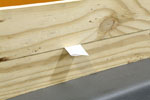

Glue line edge is a term used to describe the
edge surface in which two pieces of wood can be bonded together by a combination
of glue and pressure. The solid wood panels produced are used mainly in
cabinet, furniture and millwork market segments. The panels produced must
have undetectable joints free of open areas or visible glue build-up pockets.
Typically, the edges for glue-up are prepared in one of the four ways described
below. When comparing the various methods, it is clear that the Diehl rip
saw provides the best solution for producing the best quality panels with
the least amount of defect and effort.
The table saw/jointer method
requires multiple machines and is slow production. The jointed edge does
straighten the stock and provides a smooth edge. However, by using a cutterhead,
it closes the edge grain, limiting the glue penetration into the wood,
reducing panel strength. Both the table saw and jointer require the operator
to hold the stock as it is fed past the blade or through the cutterhead.
-------------------------------------------------
Over cutting rip saws (typically
imported models) produce a marginal edge. The best possible cut this type
of saw can produce is a cross hatch mark which is caused by the leading
and trailing edge of the blade both cutting the stock. The cross hatch
mark can leave glue build-up pockets. The limited saw blade gullet clearance
does create some blade deflection affecting the perpendicular edge to face
accuracy. Consequently, the best clamping method is by pipe clamps or clamp
carrier where excess force can be applied to close the edge gaps. The over
cutting saw by its design will have a significant amount of stock kickbacks.
------------------------------------------------- 
Gang rip saws provide
the most productive method of ripping lumber. Like the over cutting rip
saws, the best possible edge you can produce will have a cross hatch mark.
While ripping multiple pieces may be productive, the stress released when
ripping boards is difficult, if not impossible, to control on the leading
and trailing edge with the dip chain design. Consequently, the best clamping
method is by a clamp carrier where excess force can be applied to close
the edge gaps.
--------------------------- ------------
------------
Diehl straight
line rip saws utilize an under cutting design. They are
capable of producing a straight or hollow cut on the edge. By design, the
Diehl straight line rip saws cut with only the leading edge of the blade,
eliminating any cross hatch marks or visible saw kerf marks. The unique
capability of producing either a straight or hollow cut makes the Diehl
saw the most practical choice for RF (radio frequency) or clamp glue-up.
Producers of high-end panels use the hollow-cut joint to assure there is
minimal stress in the panel on glue-up and it eliminates open end defects
from occurring. The undercutting design also provides greater control of
the stock while ripping, reducing stock kickbacks from occurring.
----------------------------------------------------
Typical
hollow cut will produce a slight concave cut approximately
.002” - .004” over a 4’ long board. This is shown with
paper in the hollow. Both ends of board are tight.